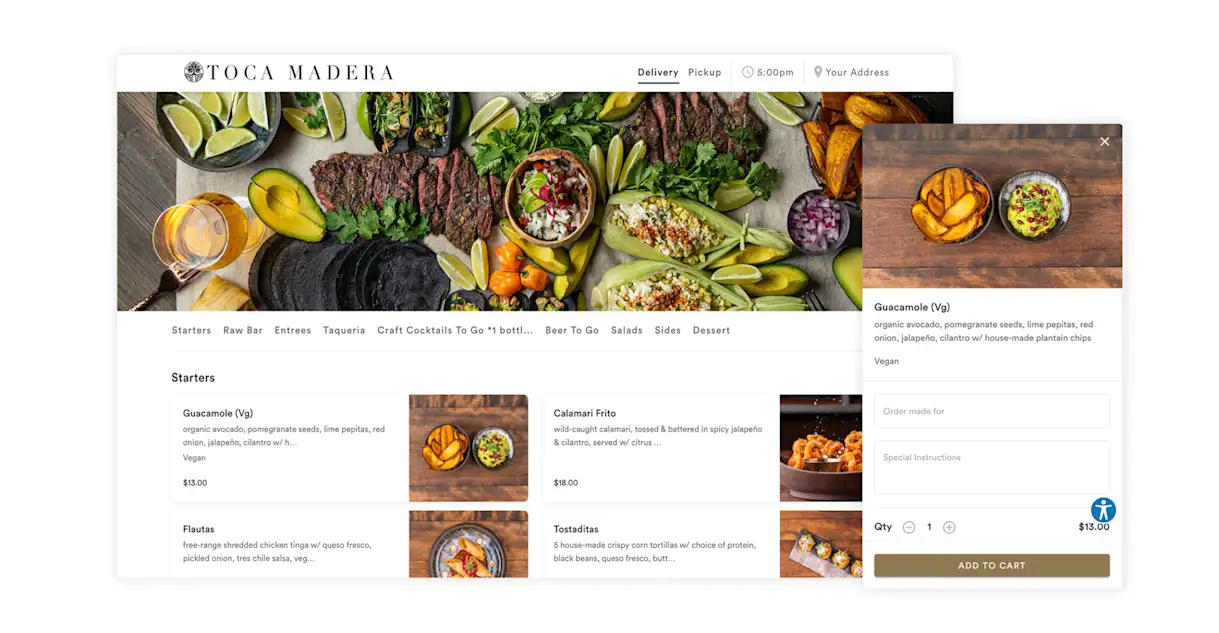New Openings
How to Open a Ghost Kitchen
September 22, 2021
Tap into the growing delivery market with the industry's fastest-growing revenue model.
Picture this: A diner is scrolling through a delivery app for somewhere new to dine. He or she stumbles upon a restaurant they haven’t heard of and decide to look it up online before placing an order. Upon digging, they learn that this restaurant doesn’t even allow guests to sit in a dining room, because it has no dining room. Instead, it operates completely within the confines of a commercial kitchen.
This restaurant, like thousands of others, is a ghost kitchen.
Ghost kitchens are on the rise due to small real estate needs, optimal back-of-house efficiency, the popularity of delivery apps and a myriad of other factors. But what exactly is a ghost kitchen – and what’s the most efficient process for how to open a ghost kitchen?

PRODUCT
Online Ordering for Restaurants
Drive more revenue with unified, branded, commission-free online ordering.
What is a Ghost Kitchen?
A ghost kitchen is a restaurant that serves its food exclusively for consumption off-premises. Most ghost kitchens are delivery-only and solely accept orders online through first-party and third-party platforms. Some ghost kitchens, however, do offer takeout or drive-thru options – though these restaurants are the exception to the norm. By 2030, it’s expected that ghost kitchens will make up 50% of the takeout and drive-thru dining sectors.
Ghost kitchens can operate as a stand-alone business for new restaurateurs to test their concepts. However, they can also act as brand extensions from notable restaurant businesses. For example, ghost kitchen It’s Just Wings actually shares a parent company with Chili’s.
Sometimes referred to as “dark,” “cloud,” “shadow” or “virtual” kitchens, ghost kitchens offer restaurateurs multiple benefits, including:
Lower real estate costs, such as overhead, property, maintenance, cleaning and other front-of-house-related expenses.
Smaller staffs, since there are no servers and delivery can be outsourced.
A simplified startup process, as ghost kitchens have lower setup needs and expenses.
However, ghost kitchens do have their drawbacks. Some of the most noteworthy are:
Limited customer interactions, as most ghost kitchens won’t ever see their guests in person. As a result, ghost kitchens sacrifice direct customer feedback and control over the dining experience.
High delivery costs due to high third-party delivery commission rates.
Constrained menu options, since not all foods are best consumed off-premises (i.e., don’t “travel well”).
Despite these cons, the advantages of ghost kitchens are so evident that thousands of them are currently operating around the country. It’s no wonder why current and aspiring restaurateurs are looking to open one of their own. With that said, here’s a step-by-step process for how to open a ghost kitchen and start capitalizing on their growing demand.
How to Open a Ghost Kitchen
1. Choose a Concept and Develop a Menu
First and foremost, a ghost kitchen concept needs to be:
Unique, and…
Appealing to off-premise diners.
Successful ghost kitchens prioritize foods that are high-selling and feasible options for delivery and takeout. Popular delivery options include:
Fried chicken dinners and sandwiches.
Comfort food like mac ‘n’ cheese.
Asian cuisine like sushi, pad thai and chicken tikka masala.
Mexican cuisine like tacos, burritos and chips & guacamole.
Breakfast sandwiches and beverages.
On the other hand, some food options aren’t suitable for delivery due to diner preference and their inability to travel well in to-go packaging. These less-than-favorable delivery items include fried foods, eggs and fine-dining entrees like steak.
With these restrictions in mind, ghost kitchens should create a menu of options that are intended for consumption up to an hour after being prepared and will fare well with local tastes. Your initial menu can also be limited in order to see what resonates with diners and optimize inventory management and kitchen operations.
2. Write a Business Plan & Source Funding
The first actionable step to starting a ghost kitchen is to create a business plan. It doesn’t matter if the ghost kitchen is an extension of an existing brand or if it’s a totally new concept – every new restaurant needs a business plan.
Experienced restaurateurs know that the business plan is the first legitimate step in creating a thriving business. It encourages its writer to think through major topics like funding, financing and operations before breaking ground on the business. Restaurateurs can use this restaurant business plan template to start crafting a plan.
In addition, most businesses require funding to get off the ground – and that includes ghost kitchens. While expenses may be smaller than a typical restaurant, ghost kitchens can still cost tens or hundreds of thousands of dollars for equipment, a location, proper licenses, marketing and other early purchases.
When stuck on this step, here are some restaurant financing tips to help get funds faster.
3. Choose a Location
Selecting a location for a ghost kitchen harkens back to its concept. If the operation is simply a brand extension, it’s completely acceptable to run the restaurant in an existing restaurant’s kitchen, similar to what Chuck E. Cheese does with its ghost kitchen concept, Pasqually’s Pizza & Wings. This option makes the hunt for space, staff and equipment much simpler. However, it runs the risk of overwhelming back-of-house staff and misleading customers when offering the same food from a different brand name.
Selecting a unique location is the only option for new restaurateurs, and the choice on where to operate should be based on the availability of kitchen space, alongside a feasibility study to see if the concept would succeed in its proposed location.
Kitchen space can be bought and converted to meet the needs of the restaurant, but this is time-consuming and expensive. The other option is to rent kitchen space, which would involve utilizing an established kitchen for a short period of time. Companies like The Kitchen Door, Kitchen United and Cloud Kitchens allow up-and-coming concepts to enter the ghost kitchen market by renting space in licensed commercial kitchens to prepare and sell their food.
4. Adhere to Restaurant Regulations
Despite not having a front-of-house, ghost kitchens are subject to the same regulations and licenses that affect restaurants. Preparing and serving food must be done safely and with the proper precautions, which often requires permits.
The restaurant permits and licenses needed to legally operate include, but are not limited to, a:
Business license.
Food service license.
Employee health permit.
Seller’s permit.
Resale permit.
One final note: Without seeing customers day-in and day-out, the focus of the ghost kitchen can quickly become output rather than ensuring the quality and integrity of dishes. This mindset can be a ghost kitchen’s downfall. Food safety and quality should never be overlooked since doing so can cost a restaurant repeat customers and potentially get it shut down.
5. Develop a Distribution Strategy
Ghost kitchens need an ironed-out plan for how food will get to customers. The first decision is whether to offer direct customer pickup. Most ghost kitchens forgo this option to streamline the process for drivers and spend less time and money perfecting the restaurant’s facade. However, there are financial benefits to offering pickup or drive-thru options. For example, if a third-party delivery app charges a 30% commission for delivery, offering a 10-15% discount for pickup ordered directly from the business can save the restaurant and the guest money.
The other decision is which delivery methods to utilize. Using one or more delivery partners like Uber Eats, Grubhub or DoorDash means order volume will almost certainly be higher than if they were not used. However, not every delivery app is right for every ghost kitchen, so third-party options should be evaluated for their merits and drawbacks before signing up. It’s important to factor commission costs into menu prices when partnering with these services,
As an alternative, ghost kitchen businesses can use in-house delivery solutions that eliminate third-party commission fees. The drawback, however, is that restaurants sacrifice exposure and opportunity for new customer acquisition inside a third-party’s marketplace. These first-party delivery solutions might also be hosted via a third-party delivery app, which further simplifies the back-end management of this software.
Regardless of how food gets to customers, it’s imperative that meals are sent out of the kitchen in takeout-friendly packaging and containers that preserve intended temperature and keep specific foods separated until they’re ready to be consumed.
6. Get the Right Technology
Like all restaurants, ghost kitchens need a suite of tools and technology in order to run smoothly. Naturally, this means POS software, as well as an integration system like ItsaCheckMate or Otter to sync online ordering directly to the POS.

If orders are accepted directly from guests, online ordering software is a must, alongside a restaurant analytics platform to easily analyze sales and produce actionable insights to improve the business. Finally, online loyalty programs can incentivize first-time diners into becoming repeat customers for a restaurant by rewarding takeout purchases with discounts or free items.
7. Create a Marketing Plan
A detailed marketing strategy should touch upon all of the ways a ghost kitchen will stand out in its market, acquire new customers and retain existing ones.
There is a sea of general restaurant marketing tips on the internet, but here are some marketing ideas specifically for ghost kitchens:
Create a restaurant website to boost SEO and discoverability, allow curious diners to learn more about the business and link to online ordering options.
Build a social media presence and promote social accounts on order receipts. Food pics, discount codes and menu specials are quick and easy fodder for filling up a social media feed.
Promote the restaurant on delivery apps by paying a premium to place higher than competitors on customer searches. Although financially unsustainable, it’s a good practice for newly opened restaurants to build awareness and acquire new customers.
Fill out a marketing plan unique to the ghost kitchen.
8. Staffing and Training
The good news for ghost kitchens is they require less staff than their full-service counterparts do. With no need for servers, order-takers or counter workers, employees can focus solely on cooking, packaging and organizing orders for pickup.
However, that means the pressure is on to run the kitchen as smoothly as possible. This starts with staffing the right employees and training them to strictly adhere to your operating model.
As the restaurant staffing crisis persists, ghost kitchens need to take proactive measures to appeal to job-seeking cooks and gig workers. Such steps include:
Offering competitive pay and benefits.
Being transparent about advancement opportunities.
Fostering a healthy and supportive working environment.
If these offerings are not presented to potential employees, a ghost kitchen will have tremendous difficulty hiring reliable talent. Plus, great hires bring value due to easier training and a better chance of employee retention.

RESOURCE
Restaurant Job Description Templates
Hire faster with 33 templates for front-of-house, back-of-house and specialized restaurant job postings.
9. Source Suppliers
For restaurants that already have a trusted food supplier, it’s simple to utilize that same supplier for a new ghost kitchen concept. If the supplier offers bulk discounts, its even easier to gain a quick profit from the ghost kitchen, as lower food costs mean higher margins for menu items.
New restaurants, however, might struggle to find the same discounts, which is why starting off with a limited-sized menu is so important. Ordering a surplus of a few ingredients (rather than a smaller amount of multiple ingredients) streamlines kitchen operations and creates an opportunity for high-volume discounts from suppliers. Shopping around to find the supplier who offers the best value (i.e., quality for the price) gives ghost kitchens the financial breathing room they need when starting out.
10. Open Your (Virtual) Doors
Mission accomplished! Once the previous nine actions have been completed, your ghost kitchen will be fully stocked, staffed and prepared to serve hungry customers. And with ghost kitchens set to be a one trillion dollar industry by 2030, there’s no better time to build a foundation for this emerging restaurant trend.

BentoBox Marketing & Commerce Platform
Deliver Smarter Hospitality
Want to stand out online, bring in more money, engage your diners, and streamline operations?
Recommended

New Openings
14 Types of Restaurants to Consider Opening
October 5, 2023
An overview of different restaurant concepts and what to know about them.

Marketing
22 Best Restaurant Logos to Inspire Your Design
January 11, 2023
Take a look at successful restaurant logo examples, and read about why they work.

New Openings
How to Get a Liquor License in California
August 2, 2022
Everything restaurants need to know about serving alcohol in the Golden State.

